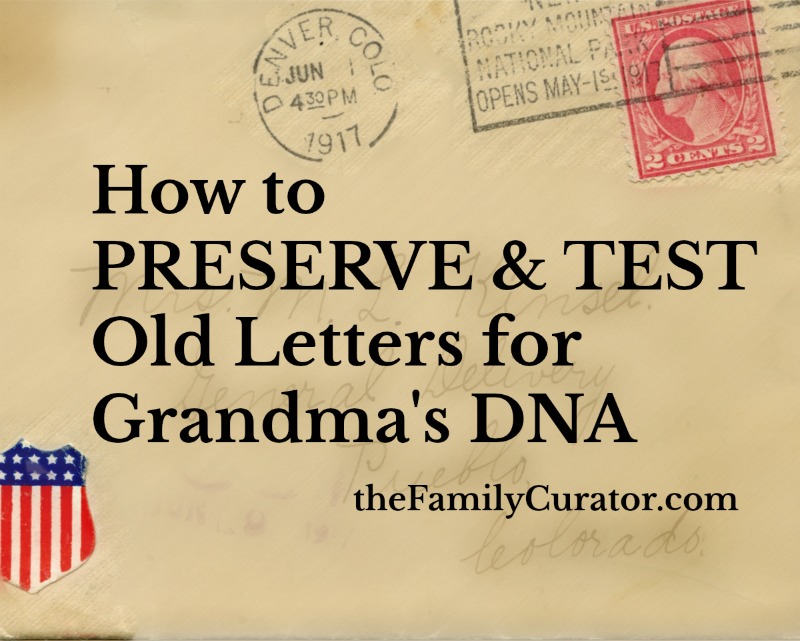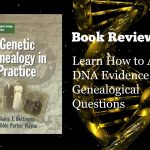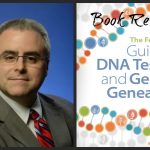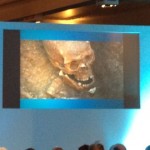DNA testing of old postage stamps, envelope flaps, and other personal artifacts will soon become readily available to the average consumer. Now is the time to locate potential specimens, preserve items in archival storage, and plan a testing strategy.
If you’ve already moved your family papers from cardboard boxes into new archival storage containers, you’re better prepared for the genetic testing of your ancestor’s DNA. Most of the questions I receive about archiving old family letters or preserving hair and hairbrushes mention saving these items for future DNA testing, but until recently, the future has seemed very very far away.
Occasional headlines have noted DNA successes in solving crimes or famous cases such as identifying the remains of King Richard III. Few cases seemed to offer DNA testing possibilities for the average genetic genealogist.
Then in February 2018, the British DNA testing company, Living DNA, announced its role in identifying the biological parents of adoptee Anthea Ring and solving a decades old abandoned baby mystery. Found under a blackberry bush by a vacationing family in 1937, Anthea’s story made headlines as Scotland Yard tried without success to locate her parents. But, it took genetic genealogy and help from experts to crack the case and identify her mother in 2016 and her father in 2018.
Discovering Anthea’s father was more difficult because he was one of six brothers, four who were potential candidates. Of those four, DNA testing of direct descendants of two brothers showed them to be first cousins to Anthea. Two brothers remained; which brother was Anthea’s biological father? Both were deceased and neither had direct descendants. However, a cousin had saved letters from one of the two remaining brothers. Living DNA was able to extract a viable sample from the letters and conclusively match Anthea’s saliva to identify her biological father. This same testing method will soon be available to all genetic genealogists.
The implications of Anthea’s story are exciting for genealogists.
Identify Old Letters for DNA Testing
I asked David Nicholson, Managing Director of Living DNA, if extracting and testing DNA samples from old letters or postage stamps would be available to the general public and he confirmed that this service would be widely available by the end of 2018 at a cost of $1,000-$2,500.
“We test both [envelope flap and stamp], depending on which have been licked and then not touched. The flap is great if a letter opener has been used,” Nicholson adds.
Look for family letters that have not been handled extensively, where the flap and seal are intact. If you have a large collection, try to find multiple samples. Nicholson noted that for Anthea’s case, tests from the postage stamp were more successful than those from the envelope flap.
Letters that have been stored inside a larger envelope, folder or box might be more pristine than those tossed loose in a drawer. Likewise, in a bundle of envelopes, look for letters towards the middle of the packet that have been protected from handling. Wear white cotton gloves when handling to avoid further cross-contamination.
In my own family archive, I have letters with flaps and postage stamps intact sent by my great-grandmother in the early 1900s. But unlike Anthea, I don’t have a targeted research problem that could be answered by testing my Great Grandmother Minnie’s DNA. And until I can develop that question and identify likely test subjects for comparison, I want to preserve those potential DNA samples in the best possible way.
Preserve Old Letters and Artifacts for DNA Testing
Nicholson recommends storing letters and artifacts for future testing inside acid-free paper folders and boxes in cool, moderate conditions. Avoid storing items inside plastic due to possible moisture.
“Just don’t freeze,” he warns. “That will damage the DNA. Store in a dry place that is not touched.”
A good option is to place items in a breathable bag or box in a dry location. Avoid moisture and heat.
And what about the artifact’s age? I asked. I hope my own letters haven’t degraded over time.
“Age can play a part,” Nicholson adds, “but it’s mainly down to how it’s been stored.”
We can’t do much to change the way our family letters and keepsakes have been stored in the past. But, a few steps can safeguard those items while they are in your care:
- Identify potential items for DNA testing and isolate from other items. Wear white cotton or nitrile gloves to avoid further contamination.
- Place the individual item in an acid-free paper folder or envelope. Avoid plastic.
- If possible, store this envelope inside an archival box or a metal file drawer to further protect from handling and temperature fluctuations. This location should be inside your home where temperature and humidity doesn’t change dramatically. Keep dry.
Click on the SHOP tab in The Family Curator Menu for recommended archival storage products.
AVOID:
- Handling and cross-contamination
- Freezing
- Moisture
- Heat
TIP: If you don’t have an archival folder or envelope, sandwich the letter and envelope between two sheets of acid-free resume paper (available at most office-supply stores). Place everything in a standard file folder or large envelope and store as directed in #3.
Should the envelope be opened and the letter sheets stored flat?
Archivists recommend storing correspondence opened flat with the envelope.
For DNA analysis, however, the less handling, the better.
Whatever you choose to do, for testing purposes, the envelope flap and seal must be unbroken.
Plan A DNA Testing Strategy
Testing DNA from your great grandmother’s letter won’t have much value without a well-defined testing strategy that fits the services offered by the testing company.
Start with a solid research question that might be answered by DNA evidence. What do you want to know, and what DNA evidence might be available to advance a solution to the problem?
- Family legend says that your adopted spinster great aunt had a secret past. You want to explore the possibility of unknown cousins. She wrote frequent letters to your grandmother that you inherited from your aunt’s estate.
- Which ancient Smith / Smythe surname is yours? You are a female and have no living male relative to test, but you do have a letter from your great-grandfather Smith.
- You’ve discovered a situation of misappropriated paternity and have narrowed the search to three deceased brothers with no descendants, all who wrote letters you now own.
It would be wonderful if an ancestor’s DNA could be uploaded and compared to a huge user-base where we could confirm cousins and discover unknown relations, following shaky leaves along the way. Or, if the raw data is available, to use the exported file for matching via third-party services. But, we aren’t there, quite yet. Right now, it’s wait and see.
Use your waiting time to learn more about DNA testing and how to use it to your genealogical advantage. Check out books, websites, webinars and institutes to learn more.
Two of my favorite books include The Family Tree Guide to DNA Testing and Genetic Genealogy by Blaine Bettinger; and Genetic Genealogy in Practice by Blaine Bettinger and Debbie Parker Wayne, reviewed here for The Family Curator.
Plan ahead. Start now by identifying potential DNA samples, moving items into archival storage, and developing research questions that take advantage of new testing options.
Extracting DNA from family keepsakes holds tremendous possibilities. The initial cost might seem expensive, and the artifact might be destroyed, but for many adoptees and family historians, the results could be priceless. Are you ready to mail your ancestor’s old letters for DNA testing?
Thanks to David Nicholson, Managing Director of Living DNA, for providing information about new testing options for family artifacts; and to Blaine Bettinger, J.D. for suggesting research scenarios that might benefit from testing heirlooms for DNA evidence.
Thank you for supporting The Family Curator by shopping with the affiliate links on this website.







I have an old whistle from my father. That was stored away for decades. Would this be a good source of DNA?
(he was never tested before he died and we are trying to identify his paternal father. )
Hi Dave, The world of DNA sample testing is changing rapidly. Check with your preferred testing company to see if they offer this service yet. If not, keep checking! And, good luck. It sounds like an interesting project.
Hello,
I have kind of a unique issue – I have more than saliva. My dad was born with a caul, a veil of skin that covered his face. I still have it – it’s been in a paper envelope, forgotten, for many years. I have purchased a testing kit, and was thinking of snipping some of it into distilled water and sending the kit off. I’m wondering about the likelihood of success – would you have a clue, or any suggestions?
Best,
Clare
Hi Clare, It sounds like you certainly do have a unique issue. Do you have a specific research question, or would you be testing the sample as a matter of personal interest? Retrieving a viable sample from artifacts seems to be a bit tricky. You might try contacting the DNA company and explaining what you’d like to do; they may have a testing protocol that would increase the likelihood of success. I’d love to know if they are able to retrieve a viable sample.
My husband’s mother passed away in 2001. She was the oldest of 6 kids. She told me at her kitchen table in 1983, while I was asking her details of my husband’s ancestors, that the father that raised her was not her biological father, but was the biological father of her 5 younger siblings. No one else in the family has heard that or admitted it to me. She has one sister, age 100, left now who has never answered my question about the different father of my mother-in-law. It is odd because she has always been very helpful answering all my family questions. That question she simply ignored.
I have stamped envelopes and letters with stickers (some may have been licked and others may have been self-sticking stickers) from my mother-in-law. Hopefully some day the stamps, envelopes, and stickers could be used to identify a connection with her real father. My husband did the ftdna.com test. Could those results connect him to his mother’s male side? My understanding is that that test was only Y-DNA (with 37 markers), which would only go back his own male line.
—Janet
Hi Janet,
You don’t mention if your husband has done autosomal (atDNA) testing, but it might be worth trying before attempting to extract samples from his mother’s correspondance. The expense will be considerably less, and the large atDNA database at Ancestry.com may yield more matches.
Blaine Bettinger’s book The Family Tree Guide to DNA Testing and Genetic Genealogy includes several good examples of different testing scenarios.
There’s a company in Australia which is already doing this, and for about half the cost LivingDNA is quoting. They accept send ins from around the world. They’re called To The Letter DNA. Granted, they only provide the raw DNA data in a format that can be uploaded to Gedmatch, they don’t provide any reports themselves. And I don’t know how reliable they are in terms of managing to extract the DNA (they warn that it doesn’t always work) – maybe Living DNA have more advanced methods.
Thanks, Robin, for the tip about this Australian company. I have not had first-hand experience with the firm, but have read some discussion via various genetic genealogy groups on Facebook. It certainly sounds like something to watch!
Do you think at some point they will be able to test hair for genetic genealogy?
Hi Laura – Some testing has been possible when hair follicles are still attached to the strand of hair, and I wouldn’t be surprised if one day there is a way to test that single hair strand. Preserve it in a marked acid-free paper envelope. Not plastic where moisture may accumulate.
This is fascinating! I have lots of letters from my grandparents and will definitely make sure to store them as suggested. However, my question is…what if you want to scan them first? Or over the years they have been read (not by many) but definitely opened? Also, why can’t the raw data be put into a database and compared to others? If not, how is the data useful? Otherwise, how is the data used by the testing company to solve a mystery if its not compared to other dna? And I assume all things are possible moving forward and maybe the cost will continue to come down as the technology is improved or more people want to use it, no?
These are exciting times for heirlooms and DNA testing. I understand that you might want to scan the letters before sending them off, but it is the envelope — specifically the gummed seal or the postage stamp that will hold the DNA sample. Look for letters with those areas untouched. Handle wearing nitrile or cotton gloves to avoid contamination. If the envelope has already been opened, I don’t know why you couldn’t remove the letter pages and scan them. I would avoid further handling of the envelope if you want to save it for possible testing. Of course, results can’t be guaranteed. The sample might not be viable.
As for raw data; that will be up to the company how they give the results. That is something to check before testing. It’s my understanding that the testing is quite labor-intensive, hence the higher cost. It might take new innovations to bring the price down significantly.
I have mouth swabs on quips in a regular sandwich bag taken by our funeral director within a day of my mother’s death in 2014. Nothing else was done to preserve them. Are they viable for dna testing?
I don’t know if it’s saliva or check cells or just “gunk” but he understood what I was trying to get before she was cremated.
That’s a good question! I would check with the DNA company directly and explain what you have. FTDNA uses cheek swabs rather than saliva, so they might be able to help.
Thanks for the shout-out!
Hello Martin, and welcome to The Family Curator! I agree with you — this latest DNA news is flabbergasting! The potential for genealogy research is truly astounding.